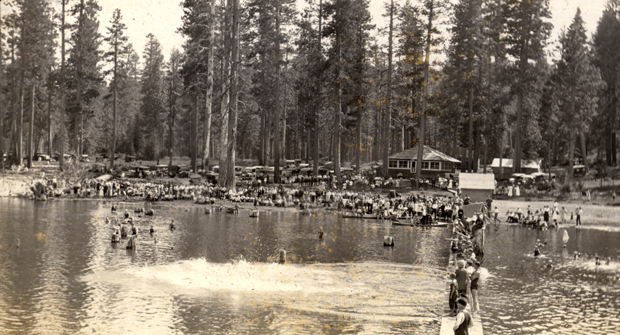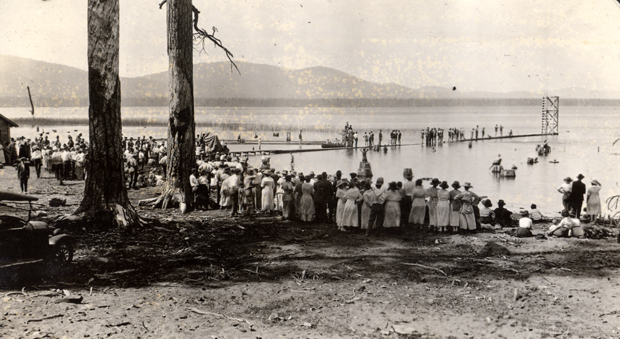
by Susan Couso
Eagle Lake has lured people to its shores for a very long time. As Lassen County was first settled, it became very appealing for small farms. Wright P. Hall was one of the first to set up a dairy farm, just south of the lake, in what became known as Papoose Meadows, but the Spalding area on the north side of the lake was thriving too.
In the late 1880’s, industrialist Albert Gallatin decided to invest in the area, and eventually spent $9,000 for nearly 5,000 acres of Eagle Lake property, mainly as grazing land for his sheep. Most of it was timberland, but Hall’s dairy farm and William Dow’s ranch near Spalding were the exceptions.
It’s not that Gallatin was a ‘sheep man’. He had been born in New York, and worked in the hardware business there, but in 1860, decided to make his fortune ‘out west’. Coming through Panama from the East, he settled in Sacramento at a very opportune time, and got a job in the hardware store belonging to Huntington & Hopkins.
This new association gave Gallatin an ‘edge’, as he became very involved with California’s ‘Big Four’; Huntington, Hopkins, Crocker and Stanford, the powerful men behind the expansion of the railroad to California. Gallatin made his fortune supplying hardware for the emerging railroads.
Gallatin dabbled in several other important ventures too. He had interests in the iron and steel and lumber business, and he was a pioneer in the development of hydro-electric power, and the transmission of electricity over long distances. He was highly involved in the California State Bank, Citizens Gas Light & Heat Co., Central Electric Railway Co., Sacramento Electric Power & Light Co., and Folsom Water & Power Company.
Several of these companies merged and then later merged again with Pacific Gas & Electric Company. Gallatin also acquired a lot of property in Tehama County.
In 1877, Gallatin built his mansion in Sacramento. He sold the mansion in 1887, and in 1903 it was purchased by the State of California and became the California Governor’s Mansion.
Meanwhile, Gallatin was promoting the virtues of Northern California’s fertile farmland and had his own farming business. The Eagle Lake property was just one of his holdings, his Tehama County ranch being the largest.
At Eagle Lake, the conditions were difficult. The trip to the lake from the Gallatin’s Tehama ranch was a trial. The snow was deep in the winter, and in 1890, conditions were so bad that everyone at the lake was out of hay for their livestock. Furthermore, drought conditions caused problems in the summers.
In 1889, Gallatin finished a storage reservoir which held 330,000,000 gallons of water.
Albert Gallatin first married in 1865. He and his wife, Nemie, had three children: Jane, Frank and Grace. In 1882, he married his second wife, Malvena in New York, and they had one daughter, Leta.
As the Gallatins left Sacramento, their principal residence was in San Francisco, where Albert died in 1905.
After Albert’s death, Malvena attempted to continue managing the Eagle Lake property, but it was not an easy task. In 1906, she made a deal to partner with a Mr. Gilliam, who would receive $66 per month for supervising her 11,000 sheep. Then, when the sheep were sold, Malvena would receive three-fourths of the profit. But she accused Gilliam of reneging on the deal and had to sue to try to get her money.
Malvena decided to turn the Eagle Lake property into her retreat, mainly as a place to spend summers with her granddaughter. In 1913, Granddaughter Norma Virginia Harvey was 13 years old, and Malvena had a two-story summer home built where Papoose Creek enters the lake. This was the first summer home at the lake. Certainly, a new idea.
For several years, she spent summers there with her beloved granddaughter, but in 1920 gave up on that idea as her granddaughter got older. Then, in 1944, her granddaughter Norma died. That Christmas, Malvena revisited her summer home, and relived its fond memories. She then left John and Alberta Christie as caretakers and never returned.
Malvena made plans to sell the retreat. She had supported the construction of the Bly Tunnel, but now, as water levels fell, she felt that it devalued her property, and sued to stop the Bly project. She lost in court.
In February 1946, she sold all but about 2-acres to Lassen Lumber & Box Company. This caused a big problem for those who thought that the lake should remain as a recreation area. By August, Lassen Lumber & Box agreed to sell to the U. S. Forest Service. They were allowed to log a certain amount, and all were appeased.
Melvena’s summer home sat idle for many years. Its fate was discussed by many who thought that the old home should be protected. It was in 1988 that salvation came in the form of the plans to build Camp Ronald McDonald at the site.







